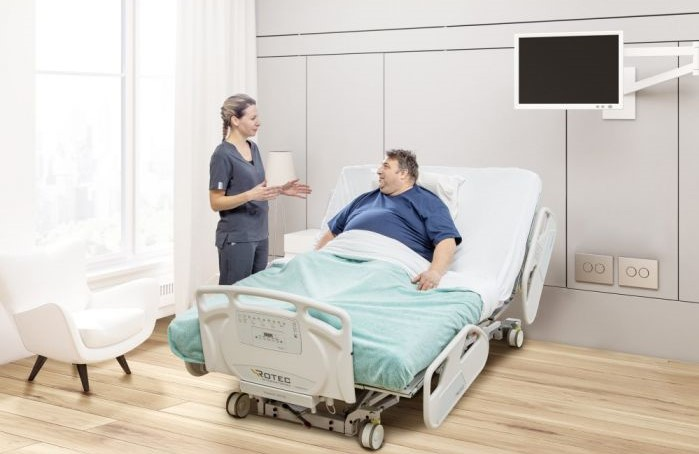A hospital bed for home use can be a welcome addition to the lifestyle of individuals living with limited mobility. When getting on and off your bed becomes cumbersome, and sometimes unsafe, the ability to raise and lower your hospital bed for home to a safe level can make a big difference in your everyday life.
Patients are not the only individuals who will find hospital bed benefits. Caregivers, whose job is to move and assist the patient will also find much welcome relief in switching from a regular bed to a hospital bed for home use.
Benefits of Using Hospital Bed at Home
1. Hospital Beds are Perfect for People who have Mobility Issues

When you lack mobility, repositioning yourself in a regular bed can be hard and frustrating. With the assistance of hand controls to raise and lower your medical bed, raise, and lower your backrest and leg rests – right behind the knees – a lot of your mobility needs are accessible at the touch of a simple button. In addition, a deluxe patient bed will also feature a one-touch Trendelenburg position setting as well as memory settings to move your backrest and leg rest in unison. Bed rails will contribute to better mobility too because they can function as a surface for the patient to help reposition themselves.
2. Easily Add Homecare Equipment to your Hospital Bed
Hospital beds for home use can adapt to a myriad of home care equipment to enhance the patient’s experience. You can choose which type of medical mattress you need to achieve the perfect level of comfort and pressure reduction – from medical bed foam mattresses to low air loss mattresses, there are many alternatives in the market to explore. Some other great hospital bed benefits are that you can attach a trapeze to help an individual reposition themselves in their med bed. Patient beds can also be used alongside overbed tables, patient lifts (sometimes known as Hoyer lifts), and other mobility accessories.
3. Provide Additional Safety and Comfort
At the very essence of owning hospital beds for home use, is the need to keep yourself or a loved one safe. The different height settings in inpatient beds are crucial in ensuring that safety. A medical bed that is positioned at a higher setting is ideal for caregivers to perform tasks such as sponge bathing and changing the patient at the perfect height. At the lowest height settings, hospital beds for home use can keep a patient safe by ensuring a minimum height in the case of falls. They also detract individuals who live with limited cognition from exiting their beds unassisted. Hospital bed rails, in addition, provide support to help the patient enter and exit the bed safely and avoid nighttime falls.
4. Hospital Beds Provide Better Positioning for Patients

Every person spending time on a hospital bed for home has a set of individual positioning needs. To avoid leg swelling and improve circulation many patients are asked to keep their legs in an elevated position. For patients with respiratory or cardiac issues, doctors recommend that they sleep with their heart and lungs positioned higher than their legs – this is addressed by raising the hospital bed’s backrest or by placing the bed in Trendelenburg position. Individuals who tend to slide down their med beds can also find support in raising the leg rest of the bed.
Difference Between a Hospital Bed and Regular Bed
Hospital Bed Sizing
Most regular beds in the market come in a selection of sizes – twin, double (full), queen and king. So what size is a hospital bed mattress? While nowadays many hospital beds for home use are being manufactured in similar sizes to standard bed, the predominant sleep deck dimension for medical beds is 35” x 80” – equivalent to a Twin XL. Most hospital beds are made in this size to avoid taking up too much space and to keep the sleep surface manageable for people with limited mobility.
Height Controls in Hospital Beds

Adjustable beds have become very popular over the last decade – individuals can control the angles of the backrest and leg rests. However, hospital beds provide the added benefit of having a deck that can be raised and lowered as a whole. This is a crucial feature that determines why patient beds continue to be the best choice for home care settings.
What is the Right Mattress Height for a Homecare Bed?
Many regular beds in the market feature ultra-high mattresses – in many cases as high as 12 inches (30 cm) tall. Hospital beds for home are designed to work with 5-inch or 6-inch mattresses. Why do hospital beds need thinner mattresses? Because the bed needs to articulate. Too thick of a mattress would make the operation of a patient bed very challenging.
Are Home Hospital Beds Taxable?
This is another major differentiation between a regular bed and a hospital bed for home. Whereas medical beds are normally taxable, in many jurisdictions like the province of Ontario, Canada, a note from a doctor can eliminate the federal and provincial taxes from your bill. This greatly alleviates the cost associated with setting up a loved one with the homecare products they need.
As humans continue to live longer– many times in the comfort of their own homes – it has become more common to find hospital beds outside formal healthcare settings. Homecare beds bring all the comfort of a hospital to the one place you call home, where your family and caregivers are close by, and where familiar surroundings bring you a sense of comfort. When caring for a loved one at home or in a residence, a hospital bed for home use will always provide a convenient and affordable way to guarantee safety and convenience.


 Home
Home










